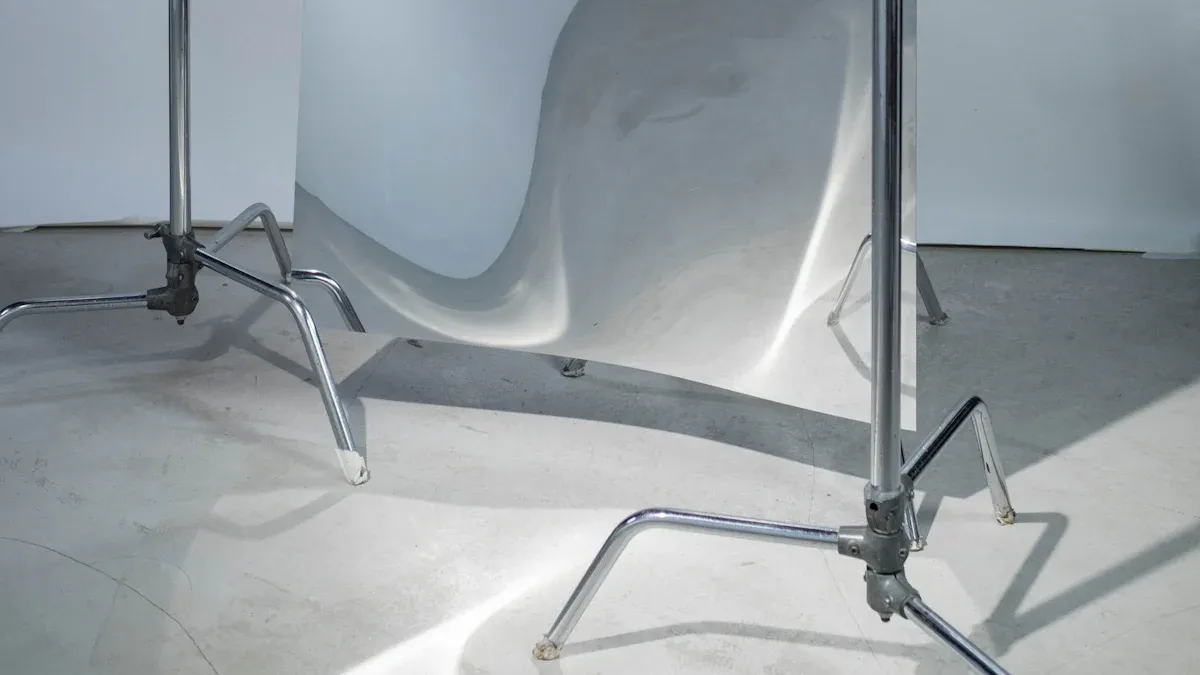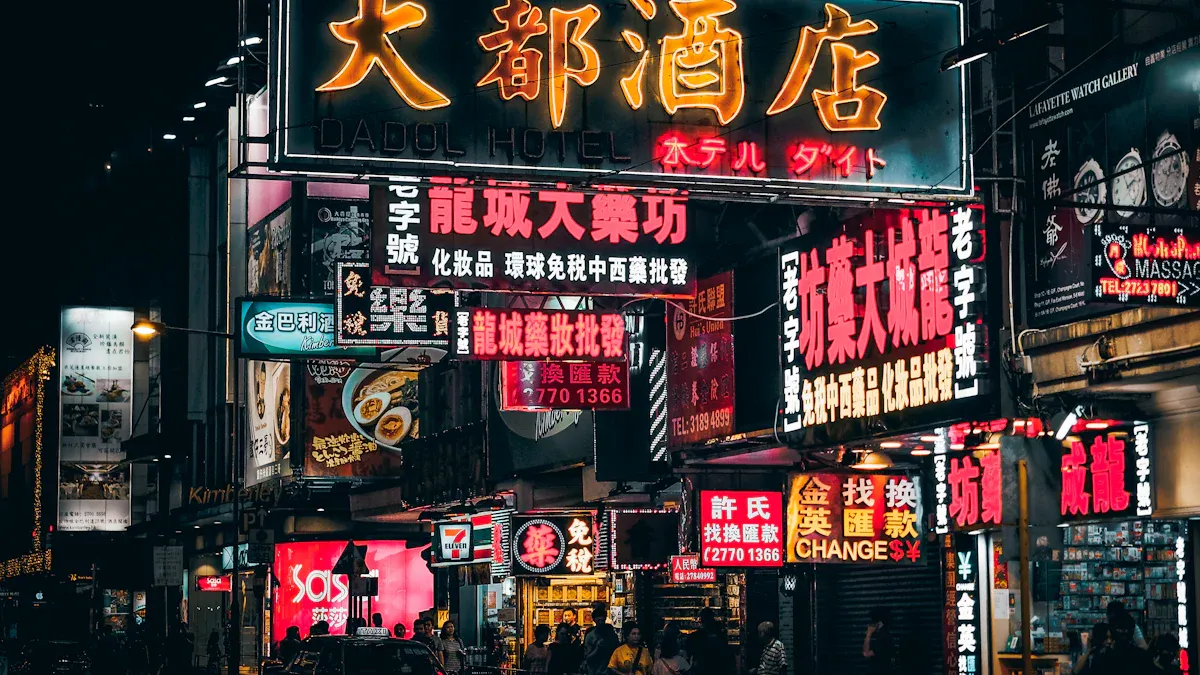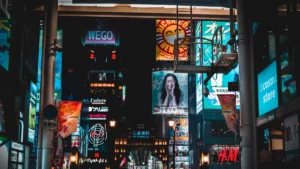For information about how Screenfluence can help your business with digital signage, please don’t hesitate to contact us by calling 1-844-772-7336 or emailing info@screenfluence.com.
Contact UsKey Elements of Effective Business Signage
Choosing the Right Colors
Colors are one of the first things people notice about your business signage. They set the tone and grab attention instantly. To make your sign stand out, use contrasting colors. For example, pairing a dark background with bright text ensures your message is visible from a distance. This contrast not only improves readability but also helps your sign pop in busy environments.
When selecting colors, think about your brand identity. Are you aiming for excitement or trust? Warm tones like red and orange create urgency, making them perfect for sales or limited-time offers. Cooler shades like blue and green, on the other hand, convey calmness and reliability. These choices can influence how customers perceive your business. As a tip, stick to a palette that aligns with your logo and overall branding to reinforce recognition.
Colors do more than look good—they evoke emotions. Red can spark passion or urgency, while blue builds trust. Choose wisely to connect with your audience.
Typography That Grabs Attention
Your sign’s message is only effective if people can read it. That’s why font selection is critical. Stick to simple, clean fonts that are easy to read from a distance. Sans-serif fonts, for instance, work well for outdoor signs because they’re bold and straightforward. Avoid overly decorative fonts, as they can confuse viewers and reduce clarity.
Font size and spacing also matter. Larger fonts ensure visibility, while proper spacing prevents your sign from looking cluttered. Limit the number of fonts you use—two at most—to maintain a professional appearance. Remember, less is more when it comes to typography. A clear, readable font not only communicates your message but also reflects your business’s professionalism.
Layout and Composition
A clean and organized layout is the backbone of effective signage. Simplicity enhances visibility, so avoid cramming too much information into one space. Instead, focus on the essentials. What’s the most important thing you want people to know? Highlight that first. Use bold text or larger font sizes to emphasize key details like your business name or a special offer.
Strategic placement of information is equally important. Place your primary message at eye level for maximum impact. Use white space to your advantage—it helps separate elements and makes your sign easier to read. A well-balanced layout not only looks appealing but also ensures your message is delivered clearly and effectively.
Pro Tip: Prioritize your message. If your sign tries to say everything, it ends up saying nothing.
Selecting Materials for Custom Outdoor Signs

Durability and Weather Resistance
Materials suited for outdoor use
When designing custom outdoor signs, choosing the right material is crucial for durability. Aluminum is a top choice because it’s lightweight, rust-resistant, and performs well in all weather conditions. If you’re in a storm-prone area, wind-resistant materials like reinforced PVC or acrylic can provide extra stability. For coastal businesses, materials that resist corrosion from salty air, such as treated metals, are essential.
Other options include wood for a rustic look, though it requires regular maintenance to prevent rot and warping. Vinyl signs are budget-friendly and versatile but may need UV coatings to withstand prolonged sun exposure. Each material has its strengths, so consider your location and weather challenges when making a decision.
Tip: If your sign will face heavy rain or intense sunlight, prioritize materials with UV and water resistance to extend its lifespan.
Protecting against fading and wear
Outdoor signage faces constant exposure to the elements, which can lead to fading and wear. UV-resistant coatings are a game-changer, protecting your sign from sun damage and keeping colors vibrant. Anti-graffiti treatments are another smart option, especially in urban areas, as they make cleaning vandalized signs quick and easy.
For wooden signs, sealing them regularly helps prevent moisture damage. Inspect your signs often for cracks, rust, or loose hardware, and address these issues promptly to avoid costly repairs. A little maintenance goes a long way in preserving your sign’s appearance and functionality.
Cost-Effective Options
Balancing quality and budget
You don’t have to break the bank to get high-quality custom outdoor signs. Aluminum strikes the perfect balance between cost and durability. It’s tough, lightweight, and rust-resistant, making it ideal for long-term use. Vinyl is another affordable option, especially for temporary signage. It’s versatile and can handle various weather conditions when UV-coated.
If you’re looking for a polished appearance without overspending, consider PVC or acrylic. These materials offer a sleek finish but may require extra care in extreme heat. By understanding your needs, you can find a material that fits both your budget and your business goals.
Exploring eco-friendly materials
Eco-friendly materials are gaining popularity in outdoor signage. Recycled aluminum reduces your environmental footprint while maintaining durability. Bamboo is biodegradable and adds a unique, natural touch to your signs. Eco-friendly plastics are non-toxic and recyclable, making them a sustainable choice.
| Eco-Friendly Material | Environmental Benefit |
|---|---|
| Recycled Aluminum | Significantly reduces environmental footprint. |
| Bamboo | Biodegradable and reduces waste. |
| Eco-Friendly Plastics | Non-toxic and recyclable, lessening pollution. |
| Durable Materials | Reduces waste by minimizing the need for replacements. |
| Solar-Powered Signage | Lowers energy consumption by utilizing renewable energy. |
Switching to these materials not only helps the planet but also appeals to eco-conscious customers.
Maintenance Considerations
Easy-to-clean materials
Keeping your outdoor signage clean is essential for maintaining its visibility and appeal. Materials like aluminum and vinyl are easy to clean with a mild soap and water solution. Avoid abrasive tools and opt for soft cloths or sponges to prevent scratches. Anti-graffiti coatings can also simplify cleaning, especially in high-traffic areas.
Long-term upkeep tips
Regular maintenance ensures your signs stay in top shape. Inspect them frequently for signs of wear, such as cracks, rust, or fading. Reapply protective coatings every few years to shield against weathering. For illuminated signs, check and replace burnt-out bulbs promptly. These small steps can significantly extend the life of your custom outdoor signs.
Pro Tip: Routine care not only saves money on replacements but also keeps your business signage looking professional and inviting.
Enhancing Visibility with Lighting

Daytime Visibility
Using reflective materials
Reflective materials are a game-changer for making your outdoor signage stand out during the day. They ensure your sign remains visible even in low-light or compromised conditions. Technologies like micro-prismatic surfaces reflect light efficiently, making your sign noticeable from various angles. Glass bead technology scatters light in multiple directions, further enhancing visibility. These materials not only improve readability but also add a layer of safety by ensuring your sign catches attention in any environment.
Positioning signage for maximum exposure
Where you place your sign matters just as much as how it looks. Position it at eye level for pedestrians or slightly higher for drivers to maximize visibility. Avoid placing it near other light sources, as they can overshadow your sign. A matte finish can also help reduce glare from sunlight, making your message easier to read. Always consider the surrounding environment to ensure your sign doesn’t blend in but instead stands out.
Pro Tip: High contrast and proper placement can make your sign unmissable, even in busy areas.
Nighttime Illumination
Incorporating LED lighting
LED lighting is a smart choice for nighttime visibility. It’s bright, eye-catching, and ensures your sign can be seen from a distance, even in bad weather. Unlike traditional neon or incandescent lights, LEDs consume less electricity, which means lower utility bills for you. They also maintain their brightness and clarity over time, ensuring your business signage always looks professional and inviting.
Backlit and halo-lit options
Backlit signs and halo-lit signs are two popular options for nighttime illumination. Backlit signs glow from behind, creating a uniform light that enhances visibility in dark environments. Halo lighting, on the other hand, produces a soft glow around the edges of your sign’s letters, adding a touch of sophistication. Both options are effective, so your choice depends on the style you want to convey.
Energy Efficiency
Choosing sustainable lighting solutions
Switching to sustainable lighting solutions like LEDs benefits both your business and the planet. LEDs use significantly less energy than traditional lighting methods, reducing your carbon footprint. They also last longer, which means fewer replacements and less waste. By choosing energy-efficient options, you’re not just saving money—you’re also showing your customers that you care about sustainability.
Reducing energy costs with modern technology
Modern lighting technology can help you cut down on energy costs. LED signs consume only a fraction of the power required by older lighting systems, leading to substantial savings on electricity bills. While the initial investment might be higher, the long-term savings make it worthwhile. Plus, you’ll spend less on maintenance, giving you more financial flexibility to invest in other areas of your business.
Note: Sustainable lighting isn’t just cost-effective—it’s a long-term investment in your brand’s future.
Customization and Branding for Business Signage
Aligning Signage with Your Brand
Incorporating logos and brand colors
Your business signage should act as an extension of your brand. Start by incorporating your logo and brand colors into the design. These elements make your signage instantly recognizable and help reinforce your identity. For example, a café in Brighton modernized its signage to match its interior design, which not only attracted more customers but also boosted its social media presence.
Consistency is key. Use the same fonts, colors, and design elements across all your signs, whether they’re outdoor signage or indoor displays. This cohesive approach builds trust and makes your brand memorable. Eye-catching signs also increase foot traffic and communicate essential information to new customers.
Clarity, readability, and consistency with branding are crucial. A simple, well-designed sign ensures your message resonates with your audience.
Maintaining consistency across all signage
Think of your signage as a puzzle piece in your overall branding strategy. Every piece should fit together seamlessly. Whether it’s a billboard, a storefront sign, or wayfinding signage inside your business, maintaining a consistent look ties everything together. This not only strengthens your brand identity but also creates a professional and polished image.
Adding Unique Features
Using 3D elements for depth
Want your signage to stand out? Add some depth—literally. Three-dimensional lettering can give your sign a sophisticated and modern look. You can even illuminate these elements for greater impact, especially at night. For instance, backlit 3D logos in high-traffic areas grab attention and make your business impossible to miss.
Incorporating interactive or digital components
Interactive signage takes customer engagement to the next level. Digital screens can display dynamic content like menus, promotions, or even social media feeds. Some businesses are even using augmented reality (AR) to create unique experiences, such as AR-enabled mirrors in clothing stores. These features not only differentiate your brand but also provide valuable insights into customer behavior.
Digital signage engages audiences more effectively than static signs. It creates memorable experiences and allows for personalized content delivery, which can boost engagement and conversions.
Tailoring Signage to Your Audience
Understanding customer preferences
Your audience should always guide your design choices. Start by analyzing their demographics—age, gender, income level, and interests. For example, vibrant colors and playful fonts might appeal to a younger crowd, while a more minimalist design could resonate with professionals.
Designing for specific locations or demographics
Location matters. Outdoor signage in a busy urban area might need bold colors and large fonts to stand out, while signage in a quieter neighborhood could benefit from a more subtle approach. Always consider the viewing distance and position to ensure your sign is legible and impactful.
Pro Tip: Test your design with mock-ups and gather feedback from your target audience before finalizing it. This ensures your signage hits the mark.
Effective signage plays a vital role in attracting customers and building a strong brand identity. It creates memorable first impressions, helping your business stand out in a crowded market. High-quality signage doesn’t just draw in new customers—it also encourages repeat visits, which is key for customer retention. For example, a local café in Brighton revamped its signage with a modern design, boosting foot traffic and enhancing its social media presence.
By applying the tips shared in this guide, you can design signage that’s visually appealing, durable, and aligned with your brand. Whether it’s incorporating 3D elements, using sustainable materials, or ensuring proper lighting, every detail matters. Remember, effective signage is more than just advertising—it’s a long-term investment that continuously promotes your business without ongoing costs.
So, take the leap and invest in signage that reflects your brand’s identity and values. It’s a decision that will pay off for years to come.



